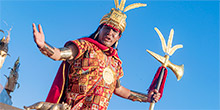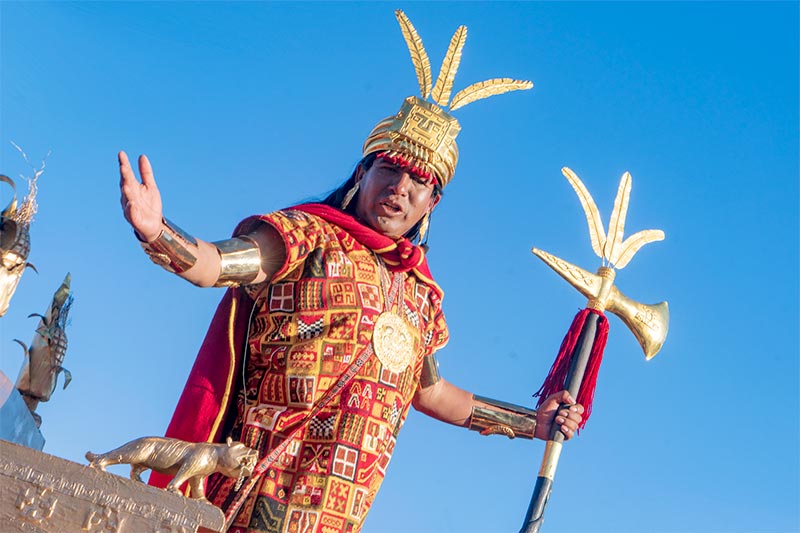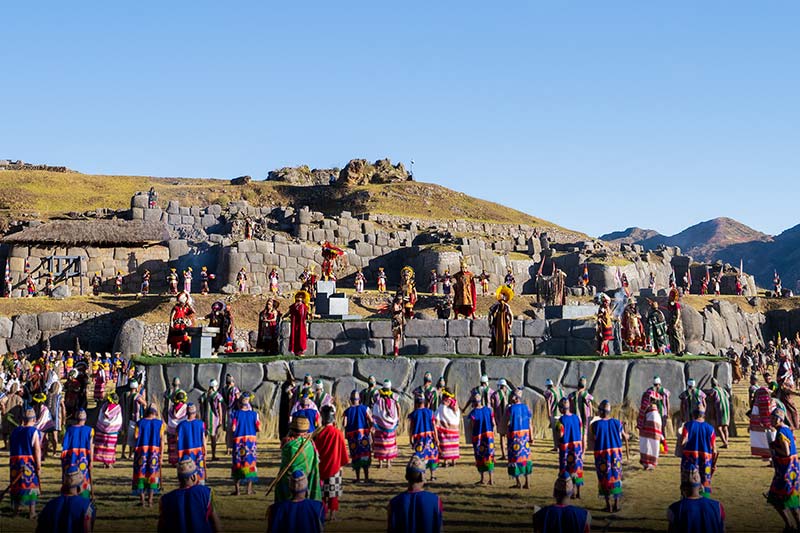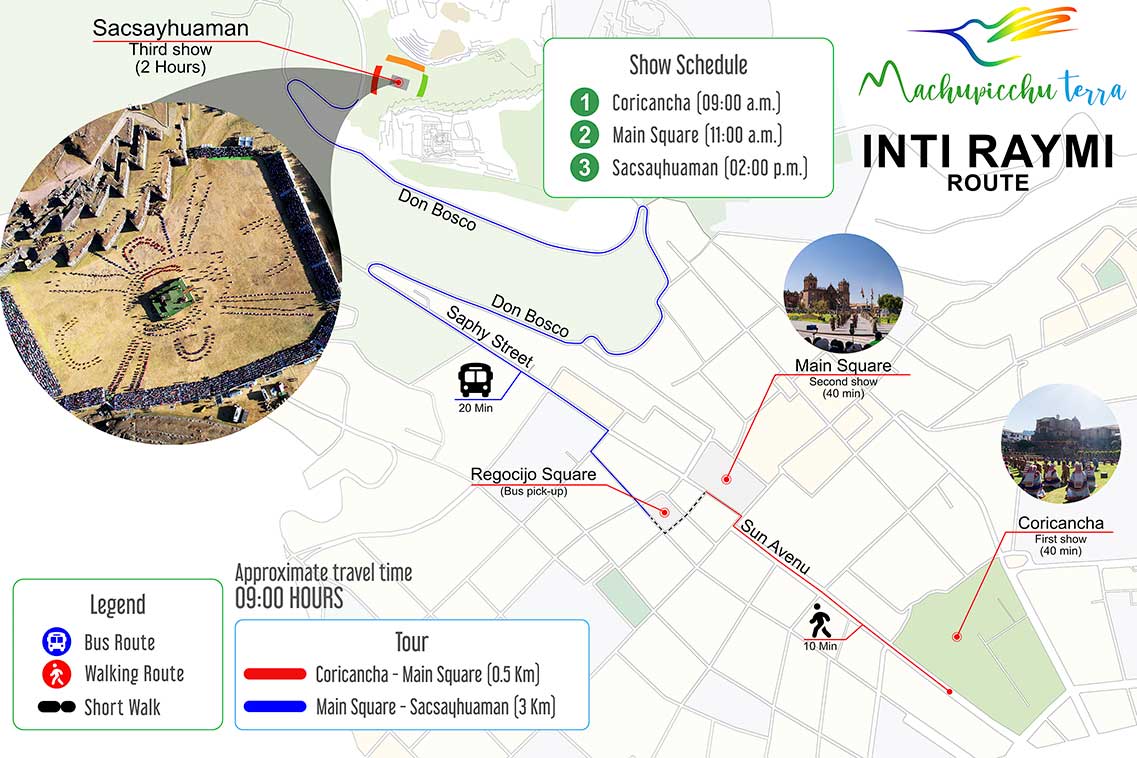What is the history of Inti Raymi in Peru?
The Inti Raymi is the most important tourist festival in Peru during the year. It is held in the city of Cuzco every June 24 through three great stagings that seek to revalue the Inca culture in the inhabitants of the region. That day is a holiday, nobody works in Cuzco. People celebrate throughout the city. Thousands of tourists arrive from all over the world. But how did this famous celebration begin, does it have its origins in the religious celebrations of the Inca empire? Learn the great history behind the great festival of the sun in Peru!
- Sun worship in the Cusco Valley
- The Inti Raymi in the era of Pachacutec
- The prohibition of the Inti Raymi in colonial times
- The new Inti Raymi in Cusco
- Ticket prices for the Inti Raymi
- Interesting facts about the Inti Raymi
How to buy a ticket to see the Inti Raymi in Cusco, Peru?
The Inti Raymi is celebrated every year on June 24 with three important performances. The first one is free for everyone and is celebrated in the Coricancha. The second is also free and free for all people in the Plaza de Armas of Cusco. The third, the most important, can be appreciated only with an entrance ticket that can be purchased online. There are several ways to buy this ticket. The most usual is through the website of the official site. But it is also possible to get a ticket, or a tour, through the web page of an authorized tourism agency. On the day of Inti Raymi (June 24), optionally, the visitor can see the shows in Coricancha (starts at 9 am and lasts 45 minutes) or in the Plaza de Armas (starts at 11 am and lasts 45 minutes). The show not to be missed is at Sacsayhuaman (starts at 2 pm and lasts 2 hours and 30 minutes). Tickets are the only way to appreciate this great show.
Sun worship in the Cusco Valley
- The Incas migrated from the altiplano (Lake Titicaca), driven away by warlike Aymara ethnic groups seeking to occupy their territory. In a mythical migration in search of new lands where they could re-found their culture, they arrived in the Cusco valley in the 12th century. Led by Manco Capac and his wife (and sister) Mama Ocllo, they reorganized their ethnic group, teaching the inhabitants of Cusco their customs, construction techniques, agriculture, ceramics and, of course, religion.
- It was thus that the Incas inserted sun worship in the valley of Cusco. The sun was the ruler of life. It is considered the father of the first Inca, Manco Capac who ordered to emigrate in search of fertile lands where to establish the new empire that would rule the world. The Incas took a sacred place in Cusco as a temple of the sun, calling it Inti Cancha (temple of the sun).
- The chronicles indicate that since the XII or XIII century the Incas worshipped the sun by making offerings of llamas, precious stones, ceramics and chicha (fermented corn). Thus, Inca astronomers, by observing the position of the stars, established the equinoxes and solstices. Because of this, they established that on June 21 (probably close to the winter solstice) the sun moves away from the earth, causing a drop in temperatures. To ask for the sun’s blessing, they organized a religious festivity called Inti Raymi or simply the festival of the sun.
- The chronicles of the XVI and XVII centuries indicate that the first Inti Raymi lasted several days and were celebrated in two scenarios: the Huacaypata or main square in the Incanate (city of Cusco) and in the Huanacaure hill, considered sacred in the Inca myths and legends. This festivity represented a new beginning of the Inca calendar. Thousands of people participated, including foreigners who came to the sacred city of Cusco.
- The ninth ruler of the Incas, the great statesman Pachacutec Inca Yupanqui, in the fifteenth century, managed to expand the territory (a great victory against the Chanca culture) and reorganized the Inca state turning it from a regional state to a great empire. It was Pachacutec, approximately in 1430, who gave great importance to this religious festivity calling it Wawa Inti Raymi. From then on, the Inti Raymi became the most important religious festivity of their calendar, together with the Capac Raymi, a festivity also dedicated to the sun, but in December, which marked the twelfth month of the Inca calendar.
The Inti Raymi in the era of Pachacutec
- Emperor Pachacutec (1418 – 1471 A.D.) was the transformer of the world in the Inca culture. Among his main works are the transformation of the Inca curacazgo into an empire, the construction of thousands of kilometers of Qhapac Ñan or royal roads, the construction of the Inca citadel of Machu Picchu, the reconstruction of the Inticancha in Coricancha, the reorganization of Inti Raymi as the great festival in honor of the sun and other great works and reorganization of the new Inca empire (then called Tahuantinsuyo).
- The chronicles indicate that the first Inti Raymi organized by Pachacutec was celebrated in the decade of 1430 A.D. The probable date was June 21 and it lasted fifteen days or even more. During those days about 5 thousand people attended the city of Cusco, all fasting as respect to the Inca and the sun god (Inti, in Quechua language). One of the most important changes organized by Pachacutec was that the festivity took the Coricancha, the temple of the sun, as its main stage.
- The Inca Inti Raymi had religious ceremonies of great importance such as the sacrifice of hundreds of llamas. These were also distributed to feed the attendees who drank chicha or fermented corn. There were also offerings of coca leaves, precious objects (ceramics, stones, textiles), and more.
- The objective of Pachacutec was to demonstrate to the conquered peoples the great power of the nascent Inca empire through a ceremony that counted with the participation of the army and envoys of the four regions of the empire: the chinchaysuyo, the contisuyo, the antisuyo and the collasuyo. The Inti Raymi demonstrated the power and culture of the Tahuantinsuyo to possible adversaries or rebels.
- During the Inti Raymi, in addition, the successes of the Inca army in their campaigns through the different regions were reported. On occasions, the Qhapac Cocha (royal obligation) ceremony was ordered, in which the sacrifice of boys or girls from towns annexed to the Inca empire was ordered. This happened in cases of famine, natural disasters or serious illness of the Inca. The objective was religious but also to demonstrate the loyalty and submission of the peoples attached to the Inca empire.
The prohibition of the Inti Raymi in colonial times
- In the 16th century, with the arrival of the Spaniards and the establishment of the viceroyalty of Peru, the Inti Raymi or any non-Christian religious manifestation was prohibited. Specifically, in 1572, the viceroy of Peru, Francisco de Toledo, stated that it was strictly forbidden for the Inti Raymi or any pagan ritual to be manifested again in Cusco or any region of the new viceroyalty.
- However, some manifestations such as walking around the city with the mummies of Inca rulers could not be completely suppressed and had to be replaced. The Inca mummies were removed and in their place were placed sculptures of saints and virgins of the Christian religion.
- However, despite almost three hundred years of prohibition and punishment of the Inca religion, many original religious manifestations are still present in the population of Cusco and in the Andes in general. These are, for example: the worship of the mountains as tutelary gods that protect communities or individuals in particular.
- Even many Cusco citizens continue to worship the sun, considering it a tutelary god, together with the Christian god. The most important Inca temples such as Coricancha, Sacsayhuaman or even Machu Picchu are seen among the Cusco and Andean population as sacred sites that deserve respect.
- To worship the Inca gods, ancient rituals such as the coca leaf ceremony, the payment to the earth, offerings to mother earth and more continue to be performed. Although the Inti Raymi was not practiced for about three hundred years, it was always present in the population of Cusco, the ancient capital of the Inca empire.
The new Inti Raymi in Cusco
- Many years later, on January 8, 1944, it was planned to reorganize the Inti Raymi festival in the city of Cusco. The idea came from the illustrious citizen Faustino Espinoza Navarro, writer and actor, who was also in charge of writing the script (in Quechua language) of the first great staging (he played the role of the Inca). For this he based his work on the chronicles of the Inca Garcilaso de la Vega (1539 – 1616 AD), also from Cusco. This great event was also thanks to the collaboration of the Peruvian historian Humberto Vidal Unda.
- Thus, on June 24, 1944, the first modern Inti Raymi was organized. The chosen scenario was the esplanade of Sacsayhuamán, a space of great dimensions where a historical scenario could be set up (the Inca Inti Raymi was celebrated in the Coricancha and not in Sacsayhuamán).
- The first Inti Raymi was attended by illustrious guests, among them the President of Peru Manuel Prado Ugarteche. The celebration was splendid. With time, this great Inca festivity gained in popularity. Two more historical scenarios were added: the temple of Coricancha and the Plaza de Armas (Huacaypata in Inca times). However, Sacsayhuaman was respected as the stage for the main show.
- In almost a hundred years of Inti Raymi, the cultural festival has become a great tourist attraction. The announcement of this great festival takes place in various cities such as Cusco, Lima and even the United States. On three occasions the festival of the sun was not held: in 1950 after the massive earthquake that struck Cusco, in 1970 after the devastating earthquake that destroyed the city of Yungay, and in 2020 and 2021 because of the coronavirus pandemic.
- Today the Inti Raymi continues to be one of the greatest cultural manifestations of Cusco and Peru. It is estimated that ten thousand visitors come to Cusco to live the experience of returning to the time of the Incas. It is estimated that more than five hundred actors and actresses are part of the cast that in 2001 was declared Cultural Heritage of Peru.
Ticket prices for the Inti Raymi
| TICKETS INTI RAYMI | SACSAYHUAMAN | CORICANCHA + SACSAYHUAMAN | ||
|---|---|---|---|---|
| FOREIGN | PERUVIAN | FOREIGN | PERUVIAN | |
| Green Zone | 125 USD | 52 USD | 170 USD | 78 USD |
| Orange Zone | 195 USD | 195 USD | 240 USD | 240 USD |
| Red Zone | 195 USD | 195 USD | 240 USD | 240 USD |
Interesting facts about the Inti Raymi
- The Inti Raymi of Cusco, unlike the festival of the sun in Inca times, is celebrated in the fortress of Sacsayhuaman. The chronicles indicate that it was previously celebrated in the Huacaypata (today’s Main Square), the mythical Huanacaure hill and in the Coricancha, the temple of the sun. Today, in addition to Sacsayhuaman, it is also celebrated in the Coricancha and in Cusco’s Main Square.
- The Inti Raymi in Sacsayhuaman receives 3,500 people. The only way to see this show, the main one in the celebration of June 24, is to buy an entrance ticket. That day is also declared a non-working holiday throughout the Cusco region. Citizens like to taste the delicious chiri uchú, a typical dish served cold consisting of boiled chicken, baked guinea pig, roasted corn, cheese, tortilla, and more.
- The Inti Raymi has hundreds of actors and actresses from Cusco. However, the most important roles are played by the Inca emperor and the coya (wife of the Inca). To play these roles, some requirements are necessary, such as being under 35 years old and having a perfect command of the Quechua language. Each year to represent the Inca is an honor for the aspirants.
- The Inti Raymi is celebrated in June, a month considered festive in Cusco’s calendar. That month there are many artistic manifestations, gastronomic festivals and musical shows in the city of Cusco. June is considered the best month to visit Cusco. Even to appreciate the Inti Raymi show in Sacsayhuaman it is necessary to buy the entrance ticket two or three months in advance. Otherwise you run the risk of not finding availability.
Advice from people who have been there
 By: Joaquín V.
By: Joaquín V.“The sun festival“
“A very interesting culture, with beliefs that still survive in time. I was delighted to be transported to the world of the Incas, at least for a few hours. I recommend it to anyone interested in history.“
By Ticket Machu Picchu – Last updated, May 6, 2024



